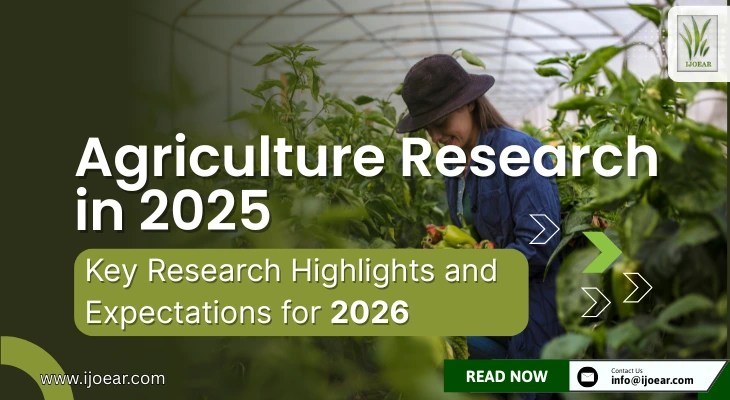
The global landscape of agriculture stands at a pivotal crossroads, driven by the intersecting pressures of climate change, resource scarcity, and the growing urgency of food security. Traditional agronomy is no longer isolated from computer science, molecular biology, or systems modeling. The objective has shifted from yield maximization to resilience, efficiency, and sustainability optimization.
This comprehensive review summarizes the key research breakthroughs of 2025 and explores the most promising avenues of agricultural innovation for 2026. Emerging technologies such as Agricultural Robotics & Automation, Predictive Agriculture, and Bioengineering form the foundation of Climate-Smart Agriculture, driving both productivity and environmental stewardship. The convergence of these disciplines marks the dawn of a new era — the Autonomous, Epigenomic Farm.
In 2025, laboratory innovations successfully translated into field-scale applications, laying the groundwork for smarter, more sustainable crop production. Researchers addressed key challenges related to data accuracy, scalability, and sustainability metrics. Below are the standout areas of progress.
The CRISPR-Cas toolbox has evolved beyond basic gene knockout applications, enabling **precise trait modification, new delivery mechanisms, and AI integration** to accelerate progress in developing climate-resilient crops.
Researchers optimized non-constitutive promoters such as the **tissue-specific RPS5A promoter** in monocots to achieve highly targeted gene editing and minimize off-target effects — a crucial step toward regulatory acceptance. The introduction of **hypercompact CRISPR-Cas12j-8 nucleases** significantly enhanced editing efficiency in staple crops like soybean and rice, enabling genetic improvements that were previously unattainable.
These advancements now allow scientists to repair deleterious mutations accumulated during domestication and fine-tune desirable traits like shoot architecture, fruit quality, and nutrient density.
High-impact research demonstrated the simultaneous editing of multiple genes to enhance tolerance against combined stresses such as heat and drought in crops like wheat and rice. This transition from single-gene manipulation to **quantitative trait stacking** ensures greater resilience to global climate variability.
Other breakthroughs include correcting harmful mutations in tomatoes to improve fruit yield and storability, as well as editing genes like FIS1 and PL to enhance fruit firmness for longer shelf life.
A highlight of 2025 was the introduction of **CRISPR-GPT**, an AI system developed to automate gene-editing workflows — from guide RNA design to data interpretation. This integration of AI with molecular biology drastically reduces the time between discovery and application, representing a leap toward autonomous bioengineering platforms.
Significant focus was placed on non-GMO-regulated delivery methods such as viral vectors, protoplasts, and particle bombardment systems for delivering Ribonucleoprotein complexes (RNPs).
A landmark achievement was the **DNA-free CRISPR-Cas9 editing in raspberry** using optimized protoplast isolation, marking a new milestone in non-transgenic plant breeding.
The concept of Digital Twins (DTs) — virtual replicas of physical agricultural systems — matured from theoretical frameworks into practical, real-time simulation platforms in 2025. They now play a pivotal role in Digital Agriculture, enabling simulation-driven optimization across the value chain.
Digital Twins integrate IoT sensors, satellite imagery, and localized weather APIs to simulate crop responses under different irrigation and nutrient conditions. This allows researchers to instantly perform **"what-if" analyses**, enhancing nutrient use efficiency (NUE) and resource management.
Recent advancements aim to build unified, scalable DT frameworks that cover entire farms rather than isolated components like irrigation or pest control.
Extended DT applications now model entire agri-food supply chains, predicting bottlenecks, post-harvest losses, and economic impacts of climatic or geopolitical disruptions. This enhances **crop traceability** and minimizes waste — particularly critical for perishable commodities.
By coupling DTs with AI-driven predictive analytics, researchers have created tools for real-time pest and disease forecasting. The development of **xDTs** — lightweight, fast-executing models deployable on Edge Computing devices — enables real-time decision-making directly on the farm, minimizing latency and complexity.
In 2025, sustainability efforts moved beyond theoretical models toward **quantifiable, nature-positive outcomes**. The focus shifted from whether carbon could be stored to how reliably it could be measured, verified, and monetized at scale.
Research accelerated around **synthetic microbial communities (SynComs)** and biocontrol agents that improve soil health and crop resilience. Studies demonstrated that hybrid chemical-biological inputs can meet soil organic matter requirements and drive soil remediation — a step toward next-generation biofertilizers.
Studies comparing intercropping and agroforestry systems quantified co-benefits like pollinator diversity, bird populations, and soil microbial activity. The emerging **"Nature Positive Agriculture"** movement prioritizes not just carbon reduction but overall ecosystem health and resilience.
As we look to 2026, agricultural research is expected to advance toward **integration, autonomy, and circularity**. The next phase will focus on scaling technologies, automating intelligent systems, and enhancing field-level adaptability.
The rise of **Agentic AI** marks a transformative leap — moving from predictive tools to autonomous decision-making systems that can act, learn, and optimize in real time.
Future models will use hierarchical Agentic AI frameworks where multiple sub-agents (for irrigation, pest control, fertilization) operate independently but align under a central Digital Twin to achieve shared objectives like profit maximization with minimal water use.
Research continues into **soft robotics** and advanced computer vision for tasks such as fruit harvesting, selective pruning, and precision spraying. Robots like BoniRob exemplify this trend, capable of weed identification and mechanical removal to reduce chemical inputs.
Optimized AI models for edge devices like drones and autonomous sensors will bridge the "phygital divide" between physical fields and digital systems — enabling instant, offline decision-making for rural applications.
2026 will witness a surge in bioengineering applications extending beyond crops to include engineered microbes, phage therapy, and epigenetic regulation.
Researchers aim to enhance **epigenetic mechanisms** like DNA methylation and histone modification to build **stress memory** in plants — allowing them to "remember" past stresses and adapt without genetic modification.
Customized **bacteriophage cocktails** are emerging as highly specific, environmentally friendly alternatives to chemical pesticides, showing promise against pathogens like Fusarium and Xanthomonas.
Synthetic biology is being applied to engineer **endophytic microbes** capable of producing phytohormones or insecticidal peptides directly within plant tissues — giving rise to living fertilizers that dynamically adapt to crop needs.
Future research will integrate water efficiency, energy optimization, and waste valorization into circular agricultural models.
Life Cycle Assessments (LCA) will guide optimization of energy-water balances in vertical farming and hydroponics. Studies on LED light spectra and nutrient-use efficiency aim to make indoor agriculture truly sustainable.
Scalable **biorefinery processes** will transform agricultural residues — such as rice husks and spent substrates — into bioplastics, bio-stimulants, and nano-fertilizers, helping agriculture evolve from a linear to a circular model.
Economic models combining **soil carbon verification** with policy tools like carbon credits and subsidy schemes will ensure fair compensation for smallholder farmers adopting climate-smart practices.
The convergence of biotechnology, AI, and sustainable farming systems signifies more than a technological transformation — it represents a paradigm shift toward intelligent, regenerative, and autonomous agriculture. As 2026 approaches, the focus will be on integrating these innovations into a unified system capable of feeding the world while preserving its ecological balance.
Q1. What is the most critical skill gap for Ph.D. students in 2026?
Integration of agronomy with data science and computational modeling. Proficiency in Python, GIS, remote sensing, and omics data analysis is essential for modern agricultural research.
Q2. How can my Master's thesis prepare me for a Ph.D. in Digital Agriculture?
Engage in projects that involve sensor deployment, data calibration, and machine learning for predictive modeling — not just data analysis.
Q3. What remains the biggest challenge for CRISPR applications?
Regulatory complexity and public acceptance. Non-transgenic systems like RNP delivery are helping overcome these barriers.
Q4. What does Agentic AI mean in agriculture?
Agentic AI systems act autonomously, execute tasks, and learn from outcomes — turning farms into self-optimizing ecosystems.
Q5. How will Digital Twins reshape the agronomist's role?
Agronomists will become data custodians and simulation analysts, focusing on refining models, calibrating IoT sensors, and interpreting predictive scenarios.
Dive deeper into the future of farming with these related articles:
 NAAS Rating: 4.23
NAAS Rating: 4.23  October 2025 Issue
October 2025 Issue  Impact Factor: 6.69
Impact Factor: 6.69  Submit Article
Submit Article 
|
Citation Indices
|
All
|
Since 2020
|
|
Citation
|
6164
|
5117
|
|
h-index
|
31
|
29
|
|
i10-index
|
201
|
165
|
|
Acceptance Rate (By Year)
|
|
|
Year
|
Percentage
|
|
2024
|
11.09%
|
|
2023
|
15.23%
|
|
2022
|
12.81%
|
|
2021
|
10.45%
|
|
2020
|
9.6%
|
|
2019
|
14.3%
|
|
2018
|
17.65%
|
|
2017
|
16.9%
|
|
2016
|
22.9%
|
|
2015
|
26.1%
|